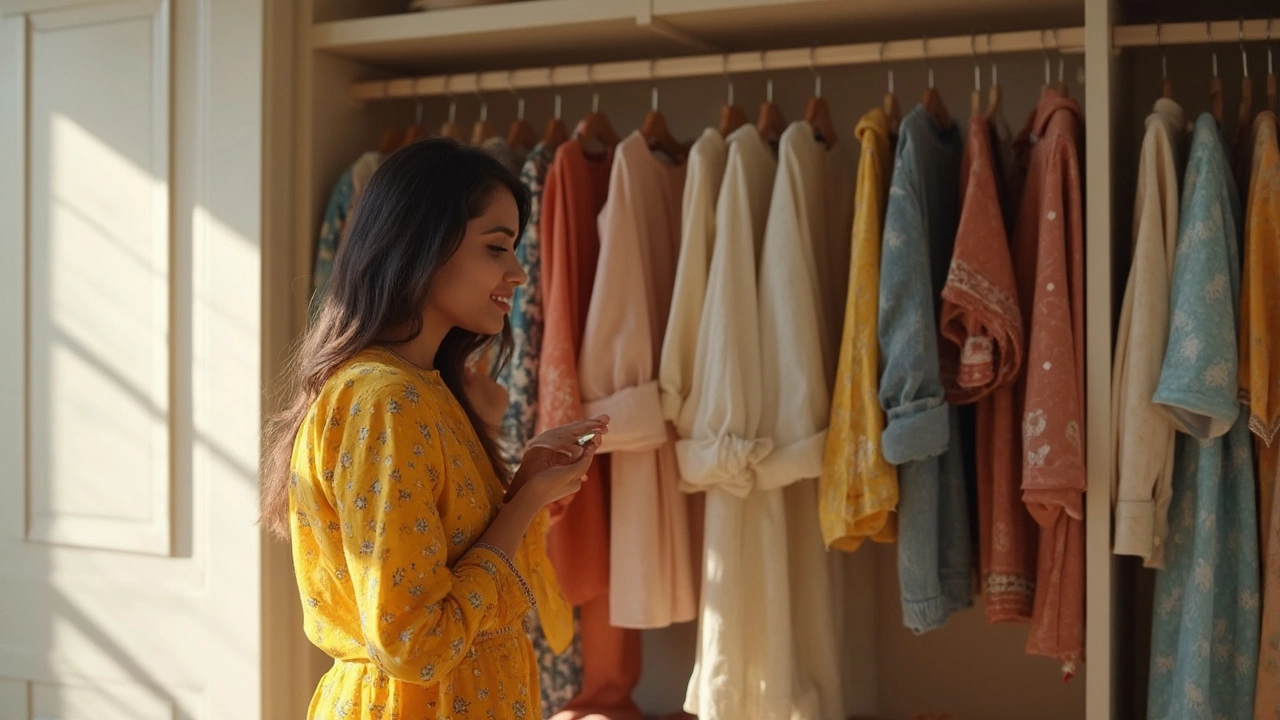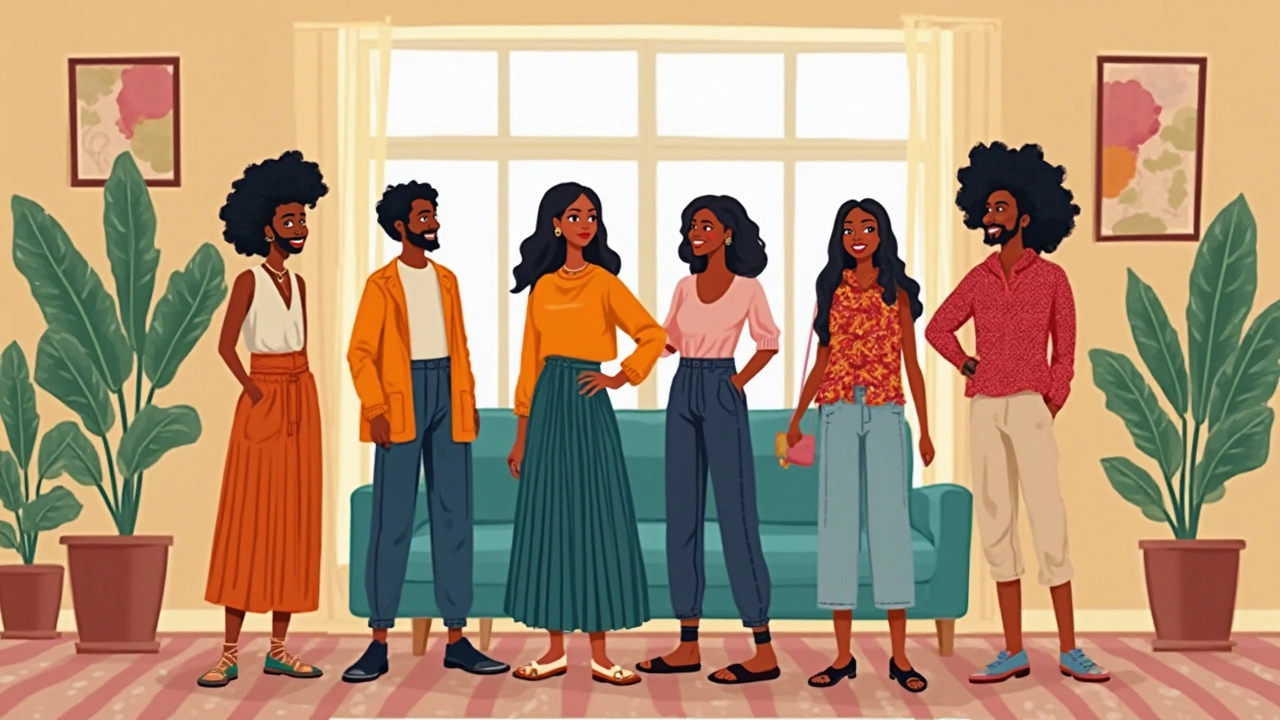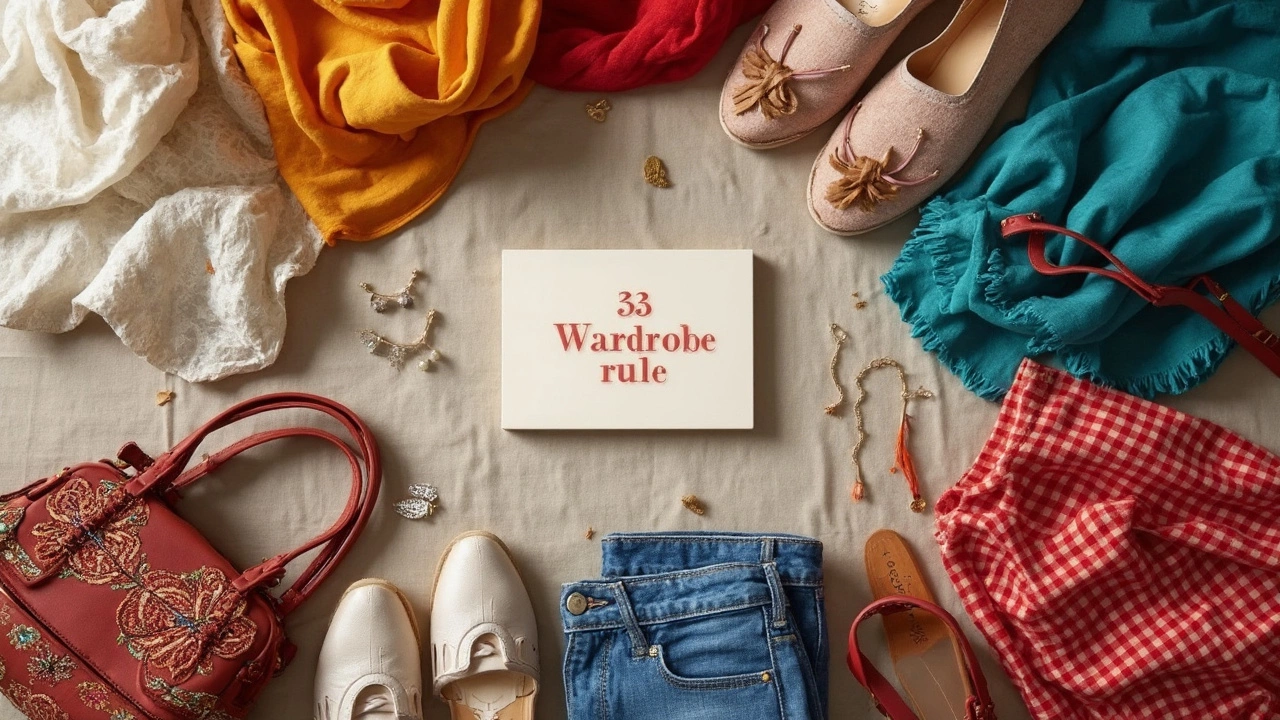
You know those mornings when you stare at your wardrobe for ages and still feel like you’ve got nothing to wear? The 33 wardrobe rule flips that whole frustration. Think of it this way: you pick just 33 clothing items, including shoes and accessories, and that’s all you wear for three months. No frantic outfit changes, no overflowing closets. Every piece earns its spot, so getting dressed actually becomes quick and—yeah—kind of fun.
When you’re building your collection of 33, you start seeing which clothes you really love and what just takes up space. It helps you focus on quality over quantity, and makes every shopping trip way less stressful. Suddenly those random impulse buys become a thing of the past. Plus, if you’re into accessories, you’ll get creative—mixing up looks with scarves, jewelry, or even classic Indian accessories like jhumkas or dupattas, without sliding back into clutter.
- What Is the 33 Wardrobe Rule?
- Origins and Why It’s a Big Deal
- How to Choose Your 33 Items (Yes—Accessories Count!)
- Swapping, Refreshing, and Sticking With It
- Benefits Nobody Talks About
What Is the 33 Wardrobe Rule?
The 33 wardrobe rule is a simple way to streamline your closet and ditch daily wardrobe stress. It means you live with just 33 pieces of clothing—think shirts, pants, dresses, shoes, and even accessories—for a set period, usually three months. These 33 items cover everything you wear outside the house except for obvious stuff like pajamas, activewear, underwear, and sentimental jewelry you never take off (like a wedding ring). The idea isn’t to punish yourself—it’s to cut out the overload and see what you actually love and wear.
This 33 wardrobe rule idea exploded thanks to the Project 333 by Courtney Carver back in 2010, and thousands of people worldwide have sworn by it since then. In India especially, where festivals, work events, and changing seasons all add up to overflowing closets, the rule makes even more sense. Pick out your 33, pack away the rest, and stick to your edit for three months. No mid-season swaps unless you totally need to replace something essential.
Here’s how the list usually looks for most people:
- 8-10 tops and shirts
- 5-6 bottoms (jeans, pants, skirts)
- 2-3 dresses or kurtas
- 2-3 jackets/cardigans
- 4-5 pairs of shoes/sandals
- 3-5 accessories (scarves, belts, earrings, a bag)
You get to define your own rules, of course—for example, adjust for special work uniforms, or go heavier on practical accessories like a hat in hot Indian summers. Either way, every piece counts, so you really think before including anything. The rule helps you focus on what works together and what you’ll actually wear, not just what looks good on a hanger.
Origins and Why It’s a Big Deal
The 33 wardrobe rule didn’t just pop up overnight. It all started back in 2010 when Courtney Carver, a blogger from the US, kicked off “Project 333.” Her idea was simple: keep only 33 items in your closet, wear them for 3 months, and see how it changes things. She wanted to cut stress, save money, and stop worrying about clothes all the time. People all over the world started trying it—and it stuck because it actually worked.
The fashion industry is one of the biggest sources of waste. India faces this too, as more people buy clothes they rarely wear, just because trends change every month. The magic of this rule is that it helps you focus on what you wear, not just what you own. It’s not about owning “less” to be trendy; it’s about finally using what’s already in your closet.
"Minimalism is not about having less. It’s about making room for more of what matters." — Courtney Carver, founder of Project 333
Why do so many folks get obsessed with the 33 wardrobe rule? First, it saves you from endless shopping and wardrobe overhauls. Second, it cuts your morning routine in half. And third, it encourages using accessories—like belts, watches, and even classic Indian pieces—to freshen up your look without buying new stuff.
Brands are noticing, too. Capsule collections and minimalist accessory lines are popping up everywhere in India. The buzz is real because it forces you to rethink every purchase. Is that chunky necklace or latest bag really needed, or is it just going to add to the mess? When you live with less, every piece gets used and loved, not buried and forgotten.

How to Choose Your 33 Items (Yes—Accessories Count!)
Narrowing down your wardrobe to just 33 pieces sounds intense, but it’s totally doable if you take it step by step. The trick is to pick items you love, that you’ll actually wear, and that you can mix and match without getting bored. And yep, accessories like belts, bags, scarves, and jewelry—those are all part of the 33-count (though most folks skip underwear, loungewear, and gym clothes).
Start by taking everything out of your closet and drawers. Lay it out where you can actually see it all. Now, be honest: which items make you feel comfortable, confident, and match your daily routine? Don’t just keep stuff out of guilt or wishful thinking (looking at you, random outfits bought for “one day” occasions).
- Pick main clothes first: Shirts, kurtas, dresses, pants, and jeans. Go for basics you wear on repeat. In India, this could mean kurtis and plain tees that work for both work and casual days.
- Add layers and outerwear: A favorite jacket, a light sweater, or a go-to dupatta will add variety, especially with changing weather. Think versatility—can this piece work with most of your wardrobe?
- Shoes: Limit yourself to two or three pairs—one casual (like sneakers), one formal or traditional (maybe juttis or a classic sandal), and one for special occasions, if you must.
- Accessories: This is where people mess up and go overboard! Pick just a couple of belts, two handbags max (day and evening), one statement jewelry piece, and a watch or favorite pair of shades. Indian accessories like bangles or jhumkas are fun, but stick to just your top couple of picks.
Here’s a quick snapshot of how your 33 items might break down on an average:
| Category | Typical Count | Examples |
|---|---|---|
| Main Clothing (tops, shirts, kurtas, pants, etc.) | 15-18 | Kurtis, shirts, jeans, trousers |
| Layers/Outerwear | 3-4 | Jacket, sweater, dupatta |
| Shoes | 3 | Sneakers, sandals, juttis |
| Accessories | 5-8 | Handbags, belt, scarf, earrings |
Keep in mind, the 33 wardrobe rule is about building a wardrobe that isn’t just smaller, but also smarter. You’ll probably panic about leaving out something, but don’t overthink it—the goal is to make your daily life easier and less cluttered. If you get creative, you can pull off a ton of different looks just from these core items. And if you really miss something, you can always swap it in at the next three-month refresh.
Swapping, Refreshing, and Sticking With It
The first few weeks of the 33 wardrobe rule feel pretty fresh. But three months in, you’ll probably get the itch to change things up. Don’t worry—it’s built into the whole concept. After every three-month cycle, you swap out what’s not working, refresh with a few things you need, and get ready for another round. It keeps things interesting and stops you from falling back into those old shopping habits.
Here’s how most folks keep the process easy and stress-free:
- Prepare for Weather Changes: Think through what you’ll actually need for the upcoming season—nobody wants to be stuck with a bunch of sweaters in the Delhi summer.
- Inspect for Wear and Tear: Check each item before swapping. Keep what’s still in great shape, and let go of things getting shabby or uncomfortable.
- Add Only What’s Missing: Maybe you realize halfway through that you don’t have any good rain footwear, or a crisp white shirt. Jot it down, and add it to your next selection. No random purchases—stick to what you need and love.
- Store, Don’t Toss: Pack away pieces you still like but aren’t using this cycle. This way, they’re not gone for good—you can bring them back in the next refresh without rebuying.
One common concern? Whether accessories really deserve a spot. Absolutely. Your favorite watch, a necklace you wear all the time, or that single statement bag? Each counts—and makes a difference.
Most people who stick with the rule see the biggest change after the second cycle. Psychologists found that when people limit what they can wear, their stress levels around getting dressed drop by over 25%. Check out the numbers below:
| Time on Outfit Decisions (Daily Avg.) | Wardrobe Stress Level |
|---|---|
| Before (Overflowing Closet) | High (reported by 8/10 people) |
| After 2 Cycles of 33 Rule | Lower (just 2/10 found it stressful) |
Just don’t get caught up in perfection. Nobody nails it the first try. Stick with the basic process, keep what works, and be okay letting go of what doesn’t. You’ll find your groove—and your signature style—way faster than you’d think.

Benefits Nobody Talks About
Here’s the thing—people love to say the 33 wardrobe rule saves time and declutters your closet. You already know that. But there are a bunch of other bonus effects people notice only after actually trying it out. Let’s call out the surprises you won’t hear in the typical minimalist talk.
First, there’s the mental boost. Researchers from Princeton found that cluttered environments can seriously mess with your focus. A trimmed-down closet means less mental distraction and lower stress, especially during rushed mornings or before that unexpected Zoom call.
You’ll also spend less cash. Not just on clothes, but all the little things—dry cleaning, fixing, even storing fashion stuff you never wear. People following this rule usually cut their fashion spending by up to 65% in a year, just by shopping less and thinking harder about what gets a spot in their 33.
Another cool change? Your style actually looks stronger. No kidding—sticking to fewer items forces you to mix and match more, and you end up finding combos you wouldn’t have tried before. And if you’re in India, rotating those same kurtas or shirts with new accessories keeps your look fresh while still sticking to the rule.
Surprisingly, folks even report being happier and more confident. A 2023 survey showed that 71% of people who tried a capsule wardrobe felt less anxious when getting dressed. The rule takes away that nagging indecision, so you get to focus on looking good and feeling good, not keeping up with every trend.
Here’s how some of these benefits stack up:
| Benefit | Stat/Fact |
|---|---|
| Lower Fashion Spending | Up to 65% less per year, on average |
| Increased Confidence | 71% felt more confident getting dressed (2023 survey) |
| Faster Getting Dressed | Averages 15 minutes less each morning |
| Better Focus | Clutter-free space linked to improved concentration (Princeton research) |
A lot of people think focusing on fewer pieces kills creativity, but honestly, the 33 wardrobe rule usually does the opposite. You learn your true style, waste less time, cut down your shopping bills, and walk out the door with a little more swagger, every single day.








Write a comment